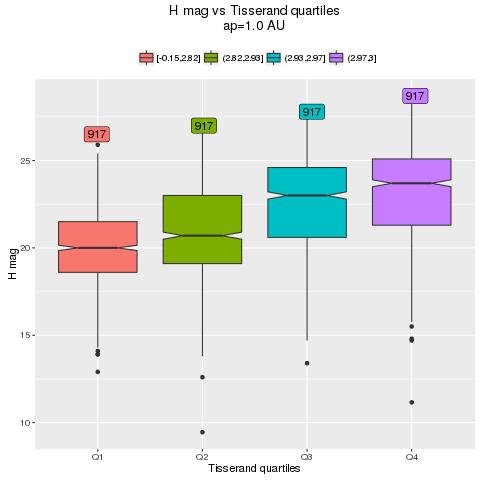The asteroid 21028 (1989 TO) is itself a recognized binary asteroid (Pravec et others). The rotation period is 3.6644 hours.
This is the result of my simulation (note, Time 0 is JD 0 --> 4713 B.C.) :
Approach
- download orbital prameters from JPL Small-Body Database
- perform simulation using Mercury6 software by John Chambers
- establish a threshold rule (distance and relative velocity) for stating that a couple of asteroids might have a common origin
- analyze results and plot using R programming environment
Orbital parameters
481085 (2005 SA135)
| Classification: Mars-crossing Asteroid SPK-ID: 2481085 |
| [ Ephemeris | Orbit Diagram | Orbital Elements | Physical Parameters | Discovery Circumstances ] |
[ show orbit diagram ]
| Orbital Elements at Epoch 2458000.5 (2017-Sep-04.0) TDB Reference: JPL 10 (heliocentric ecliptic J2000)
| Orbit Determination Parameters
Additional Information
|
21028 (1989 TO)
| Classification: Mars-crossing Asteroid SPK-ID: 2021028 |
| [ Ephemeris | Orbit Diagram | Orbital Elements | Physical Parameters | Discovery Circumstances ] |
[ show orbit diagram ]
| Orbital Elements at Epoch 2458000.5 (2017-Sep-04.0) TDB Reference: JPL 17 (heliocentric ecliptic J2000)
| Orbit Determination Parameters
Additional Information
|
Simulation setup
Let's try to investigate the last 1d8 days (about 274000 years), output interval every 100 days.
N-body algorithm: Conservative Bulirsch-Stoer
This simulation will generate a file with almost 1e6 lines per asteroid.
)O+_06 Integration parameters (WARNING: Do not delete this line!!)
) Lines beginning with `)' are ignored.
)---------------------------------------------------------------------
) Important integration parameters:
)---------------------------------------------------------------------
algorithm (MVS, BS, BS2, RADAU, HYBRID etc) = bs2
start time (days)= 2457800.5
stop time (days) = -1d8
output interval (days) = 100
timestep (days) = 0.1
accuracy parameter=1.d-12
Threshold rule
The following two conditions must be true at the same timestep:
- distance less that 0.0020 AU (about 1 lunar distance)
- relative velocity less than 1 meter/s
R custom program
I developed a small custom program to quickly analyze the results.
This program loads the output of the Mercury6 simulator (for every asteroid: a file with Time plus X,Y,Z and VX, VY, VZ).
For every couple of asteroids a dataframe is built: every row is associated to a specific timestep plus positions and velocities of the couple being investigated.
For every row, the distance and relative velocity is calculated and the threshold rules are checked.
A couple of asteroids is interesting if the threshold rule is satisfied in at least one timestep.
Once a couple is identified, a graph is built to show both distance and relative velocity.
Kind Regards,
Alessandro Odasso















